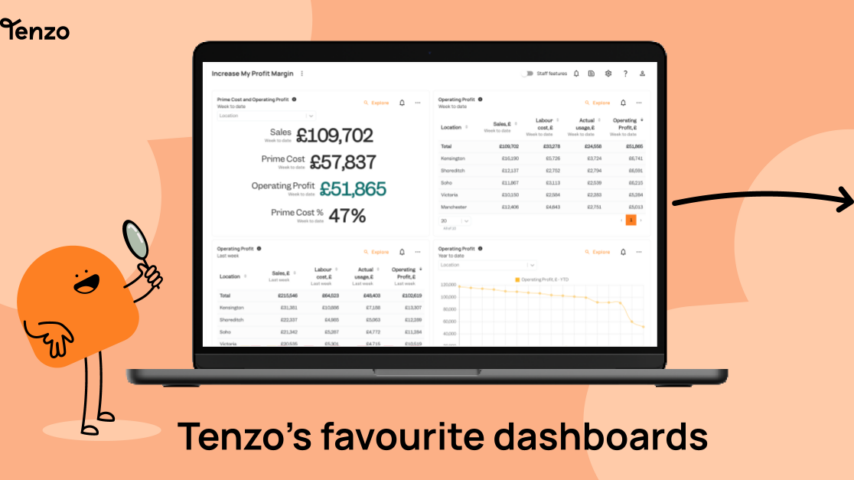Labour productivity or labour cost as a percentage of sales are crucial metrics to monitor when considering restaurant performance.
Understanding how effectively your employees are utilising their time means you can identify areas for improvement and make informed decisions to improve labour performance and optimise your operations.
However, it can be challenging for restaurants to measure this effectively. We’ve put together a guide on how to streamline labour performance, and how to measure it.
“Labour productivity is much more measurable than labour cost, as focusing on labour as a negative cost to revenue can have negative effects. Putting too much pressure on teams will have a bad impact on mental health, but the upside of an engaged team is much more important than cheaper labour”
– Scot Turner, Founder and MD at Auden Hospitality

Measuring Labour Performance
Labour productivity and labour cost as a percentage of sales are methods of measuring the efficiency of a restaurant’s workforce. In the hospitality industry, labour cost and productivity are particularly important as they directly impact the profitability and success of the business.
By measuring and optimising labour performance restaurant owners can ensure that their teams are efficient and effective, leading to improved customer service and increased revenue.
Optimising labour performance can be challenging, it involves improving employee performance, alongside careful workforce management. Calculating labour performance is an efficient method to manage this and improve your bottom line.
Calculating Labour Performance
Effective methods of measuring labour performance are calculating labour cost as a percentage of sales or labour productivity. To do this, you must have access to your restaurant’s sales and labour costs by the hour, as well as the number of labour hours deployed per hour.
Labour Cost as a percentage of Sales = (Total fully loaded labour costs ÷ total net sales) × 100
Calculating labour cost as a percentage of sales can be measured for any period, however, it is most valuable to dive into this hourly. Measuring this as an average of sales and labour data over the last 4 weeks also allows you to get more accurate and reliable data. Understanding on an hourly basis which are your most profitable, or least productive hours allows you to make adjustments to the staffing schedule and opening hours on an accurate scale.
Labour productivity = Total Sales / Total Labour Hours
Calculating labour productivity involves using labour hours as opposed to labour cost, but, it is still most accurate to get averages of the hours over the last 4 weeks. Labour productivity gives you a measure of how efficient your team is being throughout the day, and enables you to focus on the least efficient times on a granular level.

Making Changes to Optimise Labour
As we’ve mentioned, optimising labour performance can be challenging for restaurants: there are so many elements contributing to sales output – both internal and external.
When optimising labour performance, it’s important to focus on internal restaurant challenges and improving individual employees’ labour performance, alongside the management of your workforce. Optimising labour performance involves controlling costs as well as increasing sales.
Effective Labour Deployment
Effective labour deployment is key to controlling costs and optimising performance. By analysing your restaurant’s busy and slow periods, you can make adjustments to your workforce to ensure you have the right number of employees at all times. This helps you avoid overstaffing during slow periods and understaffing during busy periods.
Identifying when these slow periods are is vital to making actionable changes. When looking at sales by labour hour, or labour cost by hour, if there are certain hours and days where labour performance is down, focus on why.
Maybe there were not enough staff to deal with demand? Or, were there too many and as a result the labour costs were too high?
During busy periods, having the right number of employees ensures that you can meet customer demand efficiently and effectively. This prevents long wait times, reduces customer frustration, and improves overall customer satisfaction. By deploying your workforce to meet the demand, you can maximise performance and minimise costs.
However, during slow periods, having too many employees can lead to unnecessary labour costs. By streamlining your workforce and reducing the number of employees during these periods, you can control costs and avoid wasting resources. This allows you to allocate your budget more effectively and invest in areas that will generate higher returns.
Reducing Operating Hours
Although this is something no restaurant would take lightly, sometimes reducing operating hours is the best answer to reducing labour costs. Doing this during especially slow times can actually increase your profitability.
By analysing your data and identifying the periods of low customer demand, you can adjust your operating hours accordingly. When looking at your data, this may only be a case of opening a few hours later, however, if Mondays are consistently slow and a drain on revenue – it makes sense to close!
This not only improves employee morale and job satisfaction as your staff don’t have to work during slow periods, but it gives them more time off and flexibility. This, in turn, improves sales through improved customer interactions.
This can also benefit inventory management. Preparing in advance for slow days, or removing slow days altogether, reduces wastage and the costs that are associated with it, improving overall profitability.
Improving Sales During Slow Periods
Combating slow periods can also come from improving sales during these periods to boost performance.
If lunchtimes are consistently slow, use marketing strategies to boost sales. Offering special promotions, such as introducing lunch-time deals can entice customers to your restaurant and maximise sales opportunities, whilst keeping staff busy.
Another strategy to test out is altering opening hours to lend your business to your current customer’s spending habits. If labour performance is particularly high at the very beginning, or end, of the day consider opening earlier or later to test the overall impact. Then, monitor labour cost by hour, or sales by labour hour again after a few weeks to check the results.

Using the Free Templates
To help restaurant owners measure and track their labour productivity, or labour cost percentage by hour, we have created a couple of free templates that you can use. These templates include areas to input your own sales and labour data, allowing you to track changes in performance throughout the day and week easily.
To use the templates, simply download one below and input your data into the designated sections. The template will automatically calculate the labour cost percentage per hour, or labour productivity by hour, based on the data you provide. You can then use this information to identify trends, make informed decisions, and take steps to optimise your restaurant’s labour performance.
Implementing Automated Reporting
Although this template is completely functional in identifying trends of labour performance in your restaurant during days and weeks, automated reporting tools can provide a lot more accuracy.
When calculating labour performance during the hours of the day using this template this should be done regularly, to ensure that results are up to date with the current trends in your restaurant. Tenzo automatically does all the steps in this sheet, aggregating data from your POS and labour tools providing you with a real-time, accurate view of your labour performance throughout the day.
Implementing automated reporting tools, such as Tenzo, can greatly simplify the process of measuring and tracking labour performance. These tools can integrate with your restaurant’s existing systems, such as POS (point-of-sale) and labour scheduling software, to automatically aggregate and analyse data, giving you the insights to act on.




